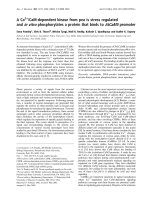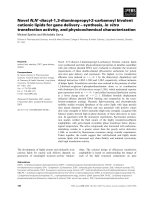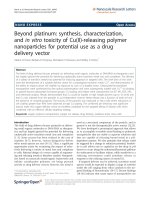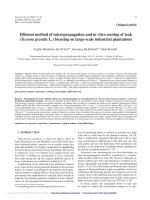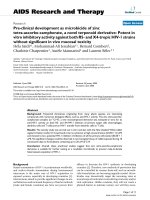New quinazolinone derivatives: Synthesis and in vitro cytotoxic activity
Bạn đang xem bản rút gọn của tài liệu. Xem và tải ngay bản đầy đủ của tài liệu tại đây (634.43 KB, 9 trang )
Vietnam Journal of Science and Technology 58 (1) (2020) 12-20
doi:10.15625/2525-2518/58/1/14391
NEW QUINAZOLINONE DERIVATIVES: SYNTHESIS AND
IN VITRO CYTOTOXIC ACTIVITY
Tran Dang Thinh, Le Thi Thuy, Ta Hong Duc, Tran Khac Vu*
School of Chemical Engineering, Hanoi University of Science and Technology
No 1, Dai Co Viet, Hai Ba Trung, Ha Noi, Vietnam
*
Email:
Received: 3 September 2019; Accepted for publication: 2 December 2019
Abstract. The paper presents a simple synthesis of a series of new quinazolinone derivatives
13a-i. First, the reaction of 5-hydroxyanthranilic acid (11) with acetic anhydride at 160–180oC
for 2 h gave the intermediate 12 in high yield. This intermediate was then reacted with amines in
acetic acid at 180 oC for 14 h to afford new quinazolinone derivatives 13a-i in 69–92%.
Synthesized compounds were structurally confirmed using spectroscopic methods: 1H, 13CNMR
and MS spectra. The bioassay result using three cancer cell lines including SKLU-1 (lung
cancer), MCF-7 (breast cancer) and HepG-2 (liver cancer) showed that only compound 13e
exhibited significant cytotoxic effect against cancer cell lines tested with IC 50 values of 9.48,
20.39 and 18.04 µg/ mL, respectively.
Keywords: 6-Hydroxy-4(3H) quinazolinone, cytotoxic, cancer.
Classification numbers: 1.2.4.
1. INTRODUCTION
Nowadays, one of the most important health-related problems in the developed and the
developing countries is cancer. It is estimated that 9.6 million deaths occur in 2018 due to this
disease. Globally, about 1 in 6 deaths is due to cancer. Additionally, statistics reported by the
International Union Against Cancer (UICC) indicated that every year, more than 11 million new
cases of cancer are diagnosed, among them more than 7 million people die of which maximum
percentage is from low and middle-income countries [1]. One of the main reasons for this could
be the drug resistance and adverse side effects of the chemotherapy [2]. In order to develop more
effective and reliable anticancer agents that overcome these limitations, the search for novel
antitumor agents is now urgent.
Over the past few years, there has been an increasing interest in the development and
pharmacology of heteroaromatic organic compounds in which quinazolinone forms an important
class of pharmacophores in medicinal chemistry due to their potential in H bonding and π–π
stacking interactions with aromatic amino acid residues of receptors [3-6]. Therefore, a number
of drug molecules and biologically active compounds often contain quinazolinone frames. In
addition, the quinazolinone frames are common scaffolds found in many diverse biological
New quinazolinone derivatives: Sythesis and in vitro cytotoxic activity
compounds, e.g. luotonin A (1), rutaecarpine (2), tryptanthrin (3), chloroqualone (4), and
alloqualone (5) (Fig. 1) [7, 8].
Figure 1. Some alkaloids containing quinazolinone moiety.
Indeed, several quinazolinone derivatives (6-10) (Fig. 2) have been reported to exhibit
various types of pharmacological activities, including anticancer [9], antioxidant [10], antiviral
[11], anticonvulsant [12], anti-inflammatory [13], antitubercular [14], anti-HIV [15], and so on.
Furthermore, quinazolinone and their derivatives have been found to display several benefits
over the agents that are clinically used [16] and closely connected to the anti-cancer therapies
[17, 18]. Some quinazolinone derivatives (6-10) (Fig. 2) were proved substantial in treating
human leukemia than the conventional agents, and showed the significant effect of
quinazolinones derivatives against breast cancer cell lines [19-22].
Figure 2. Several reported quinazolinone derivatives as anticancer agents.
Accordingly, in our continuous program for the search of novel anti-cancer agents, we
continue to focus on the synthesis of new quinazolinone derivatives, and evaluate the cytotoxic
effects on some cancer cell lines. The paper presents the result of this study.
2. MATERIALS AND METHODS
Chemistry: All products were examined by thin-layer chromatography (TLC), performed
on Whatman® 250 μm Silica Gel GF Uniplates and visualized under UV light at 254 nm.
Melting points were determined in open capillaries on Electrothermal IA 9200 Shimadzu
apparatus and uncorrected. Purification was done by crystallization and the open flash silica gel
column chromatography using Merck silica gel 60 (240 to 400 mesh). Nuclear magnetic
13
Tran Dang Thinh, Le Thi Thuy, Ta Hong Duc, Tran Khac Vu
resonance spectra (1H and 13C NMR) were recorded using tetramethylsilane (TMS) as an internal
standard on a Bruker 500 MHz spectrometer with CD3OD, CDCl3 and DMSO-d6 as solvents.
Chemical shifts are reported in parts per million (ppm) downfield from TMS as internal
standard, and coupling constants (J) are expressed in hertz (Hz). Multiplicities are shown as the
abbreviations: s (singlet), brs (broad singlet), d (doublet), t (triplet), m (multiplet). Reagents and
solvents were purchased from Aldrich or Fluka Chemical Corp. (Milwaukee, WI, USA) or
Merck unless noted otherwise. Solvents were distilled and dried before use.
Bioassay: All media, sera and other reagents used for cell culture were obtained from a
GIBCO Co. Ltd. (Grand Island, New York, USA) and three human cancer cell lines for testing
including HepG-2 (liver cancer), MCF-7 (breast cancer), and SKLU-1 (lung cancer) were
provided by Institute of Biotechnology, Vietnam Academy of Science and Technology. The
cytotoxic effect of the synthesized compounds was determined by a method of the American
National Cancer Institute (NCI) as described in literature. Briefly, these cancer cell lines were
grown as monolayers in 2 mM of L-glutamine, 10 mM of HEPES, 1.0 mM of sodium pyruvate,
and supplemented with 10 % fetal bovine serum – FBS (GIBCO). Cells were cultured for 3–5
days after the transfer, and maintained at 37 oC in a humidified atmosphere containing 5 % CO2.
Assay samples were initially dissolved in DMSO and serially diluted to appropriate
concentrations with a culture medium right before the assay. Then the cells in each well,
incubated for 24 hours as described above, were treated with 20 µL of samples at 20 µg/mL; 4
µg/mL; 0.8 µg/mL; 0.16 µg/mL. The plates were further incubated for 48 h. The medium was
removed and the cells were fixed by 10 % solution of trifluoroacetic acid. The fixed cells were
stained for 30 minutes by a staining solution (MTT). Protein-bound dye was dissolved in a 10
mM tris-base solution and the ODs were measured at 510 nm using an Elisa reader. The IC 50
values were then calculated using Probits method. Ellipticin (Sigma) was used as a positive
control and the values reported for the compounds are presented as averages of three
determinations.
Synthesis of 6-hydroxy-2methyl-4H-benzo[d][1,3]oxazin-4-one (12)
A mixture of 5-hydroxy anthranilic acid (11) (5.0 g, 32.67 mmol) in acetic anhydride (15
ml) was refluxed at 150 oC for 2 h. The mixture was then poured in ice-water. The resulting
precipitates were filtered, washed with distilled water and dried in vacuum to afford 12 (5.03 g,
87 %) which was used for next step.
General procedure for the synthesis of 13a-i
A mixture of 12 (1.0 g, 5.64 mmol) and primary amines (3 eq) in acetic acid (10 mL) was
refluxed at 120 oC for 14 h. The reaction was monitored by TLC (n-hexane : ethyl acetate = 1 :
1). The reaction mixture was then neutralized with 50 % NaHCO3 to pH = 7, and extracted with
CH2Cl2 (3 × 20 mL). The organic phase was separated, dried on anhydrous Na 2SO4 and
evaporated in reduced vacuum to obtain the corresponding residues which was subjected to
column chromatography on silica gel using n-hexane/ethyl acetate as eluting systems to give
desired 13a-i.
3-Ethyl-6-hydroxy-2-methylquinazolin-4(3H)-one (13a)
White solid; Yield: 85 %; Mp: 224-225 oC; Rf = 0.51 (n-hexane : ethyl acetate = 1 : 1); 1H
NMR (500 MHz, CD3OD, δ (ppm)): 7.50-7.48 (overlap, 2H, H-5, H-8), 7.29 (dd, J = 3.0 Hz, 9.0
14
New quinazolinone derivatives: Sythesis and in vitro cytotoxic activity
Hz, H-7), 2.66 (s, 3H, CH3), 4.22 (q, J = 7.50 Hz, 2H, H-1´), 1.36 (t, J = 7.0 Hz, 3H, CH3, H-2´).
13
C NMR (125 MHz, CD3OD, δ (ppm)): 163.3 (C-4), 157.7 (C-6), 153.6 (C-2), 141.80 (C-9),
128.6 (C-8), 125.3 (C-7), 122.4 (C-10), 110.2 (C-5), 40.8 (C-1´), 22.6 (CH3), 13.8 (C-2´). ESIMS m/z: 205.3 [M+H]+.
6-Hydroxy-2-methyl-3-propylquinazolin-4(3H)-one (13b)
White solid; Yield: 91%; Mp: 260-261oC; Rf = 0.53 (n-hexane : ethyl acetate = 1 : 1); 1H
NMR (500 MHz, DMSO-d6, δ (ppm)): 9.96 (s, 1H, OH), 7.44 (d, J = 8.50 Hz, 1H, H-8), 7.38 (d,
J = 2.50 Hz, 1H, H-5), 7.22 (dd, J = 2.50 Hz, 8.50 Hz, 1H, H-7), 3.95 (t, J = 6.50 Hz, 2H, H-1´),
2.54 (s, 3H, CH3), 1.66-1.62 (m, 2H, H-2´), 0.92 (t, J = 7.50 Hz, 3H, CH3, H-3´). 13C NMR (125
MHz, DMSO-d6, δ (ppm)): 160.9 (C-4), 155.6 (C-6), 151.4 (C-2), 140.4 (C-9), 128.1 (C-8),
123.7 (C-7), 120.9 (C-10), 108.8 (C-5), 45.3 (C-1´), 22.4 (CH3), 21.3 (C-2´), 11.1 (C-3´). ESIMS m/z: 219.5 [M+H]+.
3-Butyl-6-hydroxy-2-methylquinazolin-4(3H)-one (13c)
Bright yellow solid; Yield: 92 %; Mp: 140-141 oC; Rf = 0.57 (n-hexane : ethyl acetate = 1 :
1
1); H NMR (500 MHz, CDCl3, δ (ppm)): 7.85 (d, J = 3.0 Hz, H-5), 7.54 (d, J = 9.0 Hz, H-8),
7.31 (dd, J = 3.0 Hz, 9,0 Hz, 1H, H-7), 7.63 (brs, 1H, OH), 4.09 (t, J = 3.0 Hz, 2H, H-1´), 2.64
(s, 3H, CH3), 1.74-1.70 (m, 2H, H-2´), 1.50-1.46 (m, 2H, H-3´), 1.0 (t, J = 2.5 Hz, 3H, CH3, H4´). 13C NMR (125 MHz, CDCl3, δ (ppm)): 162.2 (C-4), 155.2 (C-6), 152.4 (C-2), 141.4 (C-9),
128.3 (C-8), 124.2 (C-7), 121.2 (C-10), 110.1 (C-5), 44.7 (C-1´), 30.7 (C-2´), 22.8 (CH3), 20.3
(C-3´), 13,7 (C-4´). ESI-MS m/z: 233.3 [M+H]+.
3-(sec-Butyl)-6-hydroxy-2-methylquinazolin-4(3H)-one (13d). Oil; Yield: 88 %; Rf = 0.57 (nhexane : ethyl acetate = 1 : 1); 1H NMR (500 MHz, CD3OD, δ (ppm)): 7.49 (d, J = 8.50 Hz, 1H,
H-8), 7.46 (d, J = 3.0 Hz, 1H, H-5), 7.28 (dd, J = 3.0 Hz, 8.50 Hz, 1H, H-7), 3.79 (m, 1H, H-1´),
1.94 (s, 3H, CH3), 1.47 (m, 2H, H-2´), 1.12 (d, J = 6.50 Hz, 3H, CH3, H-5´), 0.91 (t, J = 7.50 Hz,
3H, CH3, H-4´). 13C NMR (125 MHz, CD3OD, δ (ppm)): 172.5 (C-4), 157.7 (C-6), 154.2 (C-2),
141.5 (C-9), 128.4 (C-8), 125.2 (C-7), 109.9 (C-10), 54.8 (C-1´), 23.9 (CH3), 22.6 (C-2´), 20.4
(C-4´), 10.8 (C-3´). ESI-MS m/z: 233.3 [M+H]+.
3-Benzyl-6-hydroxy-2-methylquinazolin-4(3H)-one (13e)
White solid; Yield: 79 %; Mp: 64-65 oC; Rf = 0.50 (n-hexane : ethyl acetate = 1 : 1); 1H
NMR (500 MHz, DMSO, δ (ppm)): 8.31 (brs, 1H, OH), 7.50 (d, J = 9.0 Hz, 1H, H-8), 7.45 (d, J
= 3.0 Hz, 1H, H-5), 7.36-7.28 (m, 3H, H-7, H-4´, H-6´), 7.26-7.21 (m, 2H, H-3´, H-7´), 7.17 (d,
J = 7.50 Hz, 1H, H-5´), 5.35 (s, 2H, H-1´), 1.87 (s, 3H, CH3). 13C NMR (125 MHz, DMSO-d6, δ
(ppm)): 169.2 (C-4), 161.3 (C-6), 155.9 (C-2), 139.6 (C-9), 136.7 (C-2´), 128.8 (C-8), 128.3 (C4´, C-6´), 127.2 (C-5´), 126.7 (C-7), 126.2 (C-10), 109.1 (C-5), 46.3 (C-1´), 22.5 (CH3). ESI-MS
m/z: 267.2 [M+H]+.
6-Hydroxy-2-methyl-3-(4-methylbenzyl)quinazolin-4(3H)-one (13f)
White solid; Yield: 69 %; Mp: 246-247 oC; Rf = 0.55 (n-hexane : ethyl acetate = 1 : 1); 1H
NMR (500 MHz, DMSO-d6, δ (ppm)): 10.05 (s, 1H, OH), 7.49 (d, J = 8.80 Hz, 1H, H-8), 7.43
(d, J = 2.80 Hz, 1H, H-5), 7.28 (dd, J = 3.20 Hz, 8.80 Hz, 1H, H-7), 7.15 (d, J = 8.80 Hz, 2H, H4´, H-6´), 7.04 (d, J = 8.80 Hz, 2H, H-3´, H-7´), 5.30 (s, 2H, H-1´), 2.42 (s, 3H, CH3), 2.08 (s,
3H, CH3). 13C NMR (125 MHz, DMSO-d6, δ (ppm)): 169.5 (C-4), 161.8 (C-6), 156.4 (C-2),
152.1 (C-9), 140.9 (C-5´), 134.1 (C-2´), 129.8 (C-8), 128.8 (C-4´, C-6´), 128.2 (C-3´, C-7´),
124.6 (C-2´), 121.3 (C-7, C-10), 109.6 (C-5), 46.5 (C-1´), 23.1 (CH3), 21.2 (CH3). ESI-MS m/z:
281.5 [M+H]+.
6-Hydroxy-3-(4-methoxybenzyl)-2-methylquinazolin-4(3H)-one (13g)
15
Tran Dang Thinh, Le Thi Thuy, Ta Hong Duc, Tran Khac Vu
White solid; Yield: 79 %; Rf = 0.49 (n-hexane : ethyl acetate = 1 : 1); 1H NMR (500 MHz,
DMSO-d6, δ (ppm)): 10.03 (s, 1H, OH), 7.48 (d, J = 8.50 Hz, 1H, H-8), 7.44 (d, J = 2.50 Hz,
1H, H-5), 7.26 (dd, J = 2.50 Hz, 8.50 Hz, 1H, H-7), 7.13 (d, J = 8.50 Hz, 2H, H-3´, H-7´), 6.90
(d, J = 8.50 Hz, 2H, H-4´, H-6´), 5.27(s, 2H, H-1´), 3.71 (s, 3H, OCH3), 2.44 (s, 3H, CH3). 13C
NMR (125 MHz, DMSO-d6, δ (ppm)): 161.3 (C-4), 158.4 (C-5´), 155.8 (C-6´), 151.6 (C-2),
140.4 (C-9), 128.6 (C-3´, C-7´), 128.2 (C-2´), 127.8 (C-8), 123.9 (C-7), 120.8 (C-10), 114.1 (C4´, C-6´), 109.1 (C-5), 55.0 (OCH3), 45.7 (C-1´), 22.6 (CH3). ESI-MS m/z: 297.2 [M+H]+.
3-(4-Fluorobenzyl)-6-hydroxy-2-methylquinazolin-4(3H)-one (13h)
White solid; Yield: 81 %; Mp: 96-97 oC; Rf = 0.52 (n-hexane : ethyl acetate = 1 : 1); 1H
NMR (500 MHz, DMSO-d6, δ (ppm)): 10.04 (s, 1H, OH), 7.49 (d, J = 9.0 Hz, 1H, H-8), 7.43 (d,
J = 3.0 Hz, 1H, H-5), 7.28-7.25 (dd, J = 3.0 Hz, 9.0 Hz, 1H, H-7), 7.24-7.22 (d, J = 8.50 Hz, 2H,
H-3´, H-7´), 7.18-7.16 (d, J = 8.50 Hz, 2H, H-4´, H-6´), 5.32 (s, 2H, H-1´), 2.50 (s, 3H, CH3);
13
C NMR (125 MHz, DMSO-d6, δ (ppm)): 162.3 (C-4), 161.3 (C-5´), 160.3 (C-6), 155.9 (C-2),
140.4 (C-9), 132.9 (C-2´), 128.5 (C-8), 128.4 (C-3´, C-7´), 128.3 (C-7), 124.9 (C-10), 115.6 (C4´, C-6´), 109.1 (C-5), 45.7(C-1´), 22.6 (CH3). ESI-MS m/z: 285.2 [M+H]+.
3-(4-Chlorobenzyl)-6-hydroxy-2-methylquinazolin-4(3H)-one (13i)
White solid; Yield: 82 %; Mp: 113-114 oC; Rf = 0.53 (n-hexane : ethyl acetate = 1 : 1); 1H
NMR (500 MHz, DMSO-d6, δ (ppm)): 10.07 (s, 1H, OH), 7.49 (d, J = 9.0 Hz, 1H, H-8), 7.43 (d,
J = 3.0 Hz, 1H, H-5), 7.04-7.38 (d, J = 8.50 Hz, 2H, H-3´, H-7´), 7.28 (dd, J = 3.0 Hz, 9.0 Hz,
1H, H-7), 7.21 (d, J = 8.50 Hz, 2H, H-4´, H-6´), 5.33 (s, 2H, H-1´), 2.42 (s, 3H, CH3). 13C NMR
(125 MHz, DMSO-d6, δ (ppm)): 161.3 (C-4), 155.9 (C-6), 151.4 (C-2), 140.4 (C-9), 135.7 (C5´), 131.8 (C-2´), 128.7 (C-3´, C-7´), 128.3 (C-8), 124.0 (C-4´, C-6´), 120.8 (C-7, C-10), 109.1
(C-5), 45.8 (C-1´), 22.6 (CH3). ESI-MS m/z: 301.1 [M+H]+.
3. RESULTS AND DISCUSSION
3.1. Chemistry
Novel quinazolinone derivatives 13a-i were synthesized as outlined in Scheme 1. 6hydroxyanthranilic acid (11) was first condensed with the excess of acetic anhydride at 160 oC
for 2 h to afford the desired benzoxazinone 12 in 87 % yields. The purification of compound 12
was simply carried out by pouring the reaction mixture into the ice-water. The resulting
precipitates was filtered, washed with distilled water, and dried in vacuum. Compound 12 was
next coupled to alkyl amines, benzylamines to give target compounds 13a–i in good to excellent
yields. All the synthesized compounds were characterized by 1H NMR, 13C NMR and MS
spectra. Due to the structural similarity of target compounds, compound 13h was used as an
example to elucidate the structure of synthesized compounds. In the 1H NMR spectrum, the
chemical shift at the lowest field at 10.04 ppm is attributed to OH group. The characteristic
splitting pattern of 3 protons H-5, H-7 and H-8 as ABC system of quinazolinone skeleton was
easily observed. The proton H-5 resonates as a doublet at 7.43 ppm (J = 3.0 Hz) resulting from
long coupling with H-7. The proton H-8 resonates as a doublet at δ 7.49 (J = 9.0 Hz) due to near
coupling with H-7. The proton H-7 was observed as a doublet of doublet at δ 7.26 (d, J = 3.0 Hz,
9.0 Hz) due to coupling with H-8 and H-7. Besides, four protons of aromatic ring were observed
as two doublets at 7.24-7.22 ppm (J = 8.50 Hz, 2H, H-3´, H-7´), and 7.18-7.16 ppm (d, J = 8.50
Hz, 2H, H-4´, H-6´), and the strong singlet signal at 5.32 ppm is assigned to CH2-benzyl. CH3
group connecting to quinazolinone moiety resonates at 2.50 ppm. The 13C NMR spectrum
showed the presence of 14 carbons in the molecule, in which the carbonyl signal was observed at
16
New quinazolinone derivatives: Sythesis and in vitro cytotoxic activity
δ 162.3 ppm. The signal at δ 161.3 ppm is attributed to C-5´ due to connecting to F and signal at
155.9 ppm belongs to C-2. In addition, two couples of four equivalent carbons resonate at δ
127.8 and 115.6 ppm.
Scheme 1. Reagents and conditions: (i) (CH3CO)2O, 160–180 oC, 2 h; (ii) acetic acid, amines,
180 oC, 14 h, 69–92 %.
Table 1. In vitro cytotoxic activity of quinazolinone derivatives 13a-i.
No
Compounds
R
SK-LU-1
1
2
3
4
5
6
7
13a
13b
13c
13d
13e
13f
13g
8
9
13h
13i
Ellipticine
Ethyl
n-Propyl
n-Butyl
sec-Butyl
Benzyl
4-Methylbenzyl
4Methoxybenzyl
4-Fluorobenzyl
4-Chlorobenzyl
IC50 (µg/mL)
MCF-7
HepG-2
>100
>100
>100
>100
9.48
>100
>100
>100
>100
>100
>100
20.39
>100
>100
>100
>100
>100
>100
18.04
>100
>100
>100
>100
0.43
>100
>100
0.43
>100
>100
0.40
a
Concentration (µg/mL) that produces a 50 % reduction in cell growth or enzyme activity, the numbers
represent the averaged results from triplicate experiments with deviation of less than 10 %. bCell lines:
HepG2, liver cancer; MCF-7, breast cancer; SKLU-1, lung cancer.
All target compounds 13a-i were evaluated for their in vitro cytotoxicity. Three human
cancer cell lines including SKLU-1, MCF-7 and HepG-2 were chosen for screening their
inhibition effect using MTT method [23]. All compounds were initially screened at a fixed
concentration of 100 µg/mL. If the compounds are active, they will be further screened at
smaller concentrations (e.g., 20 µg/mL, 4 µg/mL, 0.8 µg/mL and 0.16 µg/mL), and IC50 values
for each compound were calculated (Table 1). In this assay, ellipticine was used as a positive
control.
17
Tran Dang Thinh, Le Thi Thuy, Ta Hong Duc, Tran Khac Vu
However, as shown in Table 1, most of quiniazolinone derivatives were inactive against
three cancer cell lines tested except compound 13e showing cytotoxic effect with IC50 values of
9.48, 20.39 and 18.04 µg/mL, respectively.
4. CONCLUSIONS
We have reported a series of new quinazolinone derivatives 13a-i via a simple synthetic
procedure. The structure of all synthesized compounds has been confirmed based on 1H, 13C
NMR and MS spectra. Although the bioassay results showed that most of target compounds
exhibited no cytotoxic effect in terms of cytotoxicity in comparison with ellipticine, compound
13e displayed cytotoxic effect with IC50 values of 9.48, 20.39 and 18.04 µg/mL, respectively,
suggesting that it could be served as basis for further design of antitumor agents in the future.
Acknowledgements: We acknowledge the financial supports from the National Foundation for Science
and Technology of Vietnam (NAFOSTED, grant number 104.01-2017.05.
REFERENCES
1.
Ferlay J, Colombet M. and Soerjomataram I. - Global and Regional Estimates of the
Incidence and Mortality for 38 Cancers: GLOBOCAN 2018. Lyon: International Agency
for Research on Cancer/World Health Organization; 2018. CA Cancer J Clin. 68 (2018)
394-424.
2.
Mellinghoff I. K., Sawyers C. L. - The emergence of resistance to targeted cancer
therapeutics. Pharmacogenomics 3 (2002) 603- 623.
3.
Welsch M. E., Snyder S. A., Stockwell B. R. - Privileged scaffolds for library design and
drug discovery. Curr Opin Chem Biol. 14 (2010) 1–15.
4.
Asif M. - Various chemical and biological activities of pyridazinone derivatives. Cent Eur
J Exp Biol. 5 (2017) 1–19.
5.
Nikaljea A. P., Bahetia K. - Computer based drug design of various heterocyclic
compounds having anticancer activity: a brief review. J Bioinform Genom Proteom. 2
(2017) 1–13.
6.
Yadav M. R., Naik P. P., Gandhi H. P., Chauhan B. S., Giridhar R., Design and synthesis
of 6,7-dimethoxyquinazoline analogs as multi-targeted ligands for α1- and AII-receptors
antagonism. Bioorg. Med. Chem. Lett. 23 (2013) 3959–3966.
7.
Venkatesh R., Ramaiah M. J., Gaikwad H. K., Janardhan S., Bantu R., Nagarapu L.,
Sastry G. N., Ganesh A. R., Bhadra M. - Luotonin-A based quinazolinones cause
apoptosis and senescence via HDAC inhibition and activation of tumor suppressor
proteins in HeLa cells, Eur. J. Med. Chem. 87 (2015) 94-101.
8.
Kamal A., Tamboli J. R., Ramaiah M. J., Adil S. F., Pushpavalli V. L., Ganesh R., Sarma
R., Bhadra U., Bhadra M. P. - Quinazolino linked 4β-amidopodophyllotoxin conjugates
regulate angiogenic pathway and control breast cancer cell proliferation, Bioorg. Med.
Chem. 21 (2013) 6414–6426.
9.
(a). Shetha A. and Wijdan I. A. - Synthesis and characterization of new quinazoline–
4(3H)-one Schiff bases. J Chem Pharm Res. 5 (2013) 42–45; (b). Amer M. Alanazi, Alaa
18
New quinazolinone derivatives: Sythesis and in vitro cytotoxic activity
A. M. Abdel-Aziz, Ibrahim A. Al-Suwaidan, Sami G. Abdel-Hamide, Taghreed Z.
Shawer, Adel S. El-Azab - Design, synthesis and biological evaluation of some novel
substituted quinazolines as antitumor agents, Eur. J. Med. Chem. 79 (2014) 446-454; (c)
Malleshappa N., Noolvi Harun M. Patel - Synthesis, method optimization, anticancer
activity of 2,3,7-trisubstituted Quinazoline derivatives and targeting EGFR-tyrosine
kinase by rational approach: 1st Cancer Update. Arab.J.Chem. 6 (2013) 35-48; (d). Fleita
D. H., Mohareb R. M., Sakka O. K. Antitumor and antileishmanial evaluation of novel
heterocycles derived from quinazoline scaffold: a molecular modeling approach. Med.
Chem. Res. 22 (2013) 2207-2221.
10. Zaranappa Vagdevi H. M., Lokesh M. R., and Gowdarshivannanavar B.C - Synthesis and
Antioxidant Activity of 3-Substituted Schiff bases of Quinazoline-2,4-diones, Int. J.
Chem. Tech Res. 4 (2012) 1527–1533.
11. Krishnan S. K., Ganguly, R., Veerasamy, B. - Synthesis, antiviral and cytotoxic
investigation of 2-phenyl-3-substituted quinazolin-4(3H)-ones, Eur Rev Med Pharm Sci.
15 (2011) 673–681.
12. Patel N. B., Virendra N. P., Heman R. P., Faiyaz M. S., Jaymin C. P. - Synthesis and
microbial studies of (4-oxo-thiazolidinyl) sulfonamides bearing quinazolin-4(3H) ones,
Acta Polo Pharm Drug Res. 67 (2010) 267–275.
13. Saravanan G., Pannerselvam P., and Prakash C. R. - Synthesis, analgesic and antiinflammatory screening of novel Schiff bases of 3-amino-2-methyl quinazolin 4-(3H)-one,
Der Pharmacia Lett. 2 (2010) 216–226.
14. Abid O. H. and Ahmed A. H. - Synthesis and characterization of novel quinazoline
derivatives via reaction of isatoic anhydride with schiff’s base, Inter J. Appl. Nat. Sci. 2
(2013) 11–20.
15. Pati B. and Banerjee S. - Quinazolines: an illustrated review, J. Adv. Pharm Edu Res. 3
(2013) 136–151.
16. Katrin S. N. - Chemotherapy and Dietary Phytochemical Agents. Chem ther Res Prac. 3
(2012) 22–27.
17. Manasa A. K., Sidhaye R. V., Radhika G., and Nalini C. N. - Synthesis, antioxidant and
anticancer activity of quinazoline derivatives. Current Pharma Research 1 (2011) 101–
105.
18. Nerkar B., Saxena A., Ghone S. & Thakeri A.K. - In Silico Screening, Synthesis and In
Vitro Evaluation of Some Quinazolinone and Pyridine Derivatives as Dihydrofolate
Reductase Inhibitors for Anticancer Activity. E-Journal of Chem. 6 (2009) 97–102.
19. Danilov A. V. - Targeted therapy in chronic lymphocytic leukemia: past, present, and
future, Clin Ther. 35 (2013) 1258–1270.
20. Ahmed M. F. and Youns M. - Synthesis and Biological Evaluation of a Novel Series of 6,
8‐Dibromo‐4 (3H) quinazolinone Derivatives as Anticancer Agents, Archiv der
Pharmazie. 346 (2013) 610–617.
21. Kumar D. - Design, synthesis and cytotoxic evaluation of novel imidazolone fused
quinazolinone derivatives, Arabian J. Chem. 10 (2017) 344-450.
22. Faraj F. L., Maryam Z., Mohammadjavad P., Chung Y. L., Nazia A M., Hapipah M
A., Noraini A., Nura S G., Mahmood. A. - Synthesis, Characterization, and Anticancer
19
Tran Dang Thinh, Le Thi Thuy, Ta Hong Duc, Tran Khac Vu
Activity of New Quinazoline Derivatives against MCF-7 Cells, Sci. Wld J. 212096; doi:
10.1155/2014/212096 (2014).
23. Scudiero D. A., Shoemaker R. H., Paull K. D., Monks A., Tierney S., Nofziger T. H.,
Currens M. J., Seniff D., Boyd M. - Feasibility of drug screening with panels of human
tumor cell lines using a microculture tetrazolium assay, Cancer Res. 48 (1988) 4827–
4833.
20


